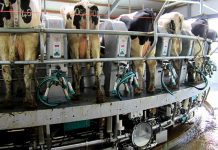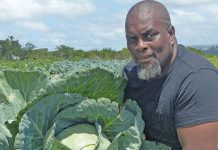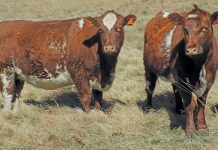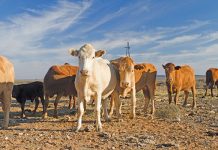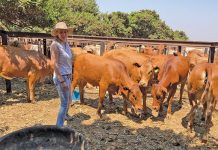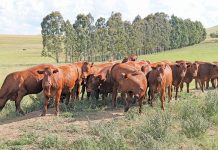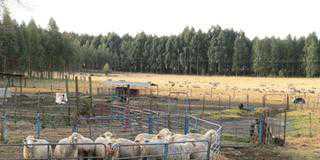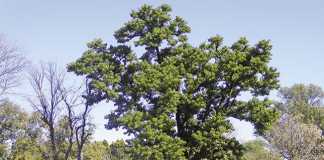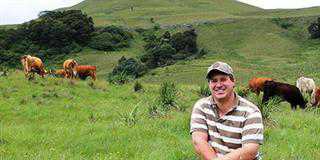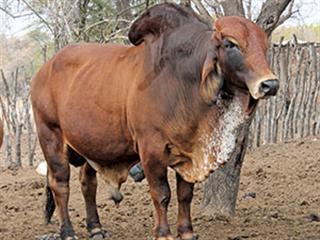
For Frekkie Sentsho of the farm Mooke village one of his biggest challenge comes with the summer rains. “Until a few years ago, I lost many cattle and goats to the toxic mogau plant, every year. It’s known as gifblaar in Afrikaans and poison leaf in English,” he says. The plant is considered one of the deadliest local plants for livestock, and Frekkie was losing at least 10 head of cattle and 15 goats to this plant every year.
“It’s even more dangerous for goats. One year I lost about 25 goats in one day,” he recalls. “I was just standing there, watching them collapse one after the other. When the fifteenth died, I climbed into my bakkie and left the farm because I just couldn’t take it anymore. This plant is not easy to eradicate and all we can do is restrict cattle movement away from infested areas. However, it’s impossible to avoid the plant altogether.”

Frekkie Sentsho
Indigenous knowledge
Frekkie recalls all the ways in which he tried to overcome the poison leaf problem. “We even called in experts from the Directorate of Veterinary Services, but nothing helped,” he explains. “So we resorted to the old traditional ways with the help of a herbalist. “Early in the season we dig up the roots of the poison leaf plant, then mix it with traditional sorghum beer before cooking it in the same beer until the roots are completely broken down. We then leave it to cool before giving each animal at least one litre of the mixture. Finally, we lock the animals up in the kraal to restrict their movement, and withhold drinking water from them for about 24 hours.
“It’s a week-long job, as the traditional beer takes about a week to prepare. Every year, we give new weaners the mixture before we let them out onto the veld.” Since starting with this method, the mortality rate has dropped by more than 80%, according to Frekkie. However, he admits it’s only a preventative measure, not a true vaccination. “Other common diseases in the area include black quarter (sponssiekte), which we can vaccinate against,” he says.
Choice of breed
Frekkie was born in 1950 on the farm Mooke village, formerly known as De Mond van Blokspruit. The farm is about 100km from Brits on the northern border of the Borakalalo National Park in North West. After leaving the farm, he went to work in a factory in Babelegi near Hammanskraal north of Pretoria. But after a while he began to hanker for farm life again and made the decision to join his father Hendrick on the farm and make a career out of agriculture.
While admitting that it is tough and challenging, he finds that he loves the work and has never regretted the move. “We were farming Afrikaner cattle,” he recalls. When Hendrick died in 1994, Frekkie took over the operation. Following his father’s death, Frekkie decided to add value to the Afrikaner cattle. After considering various options, he settled on crossing the Afrikaners with Brahmans.
This decision was influenced by the environmental conditions on the farm. He needed animals that could endure the dry winter months while retaining body condition. Today, he runs 120 mixed-breed cattle, predominantly Brahman. “Brahmans are well-adapted animals and can withstand many hardship,” stresses Frekkie.
“They perform consistently even under unfavourable conditions. Other beef breeds have larger frames, which make them suffer more when it is dry. Sometimes the dams run dry or my pump breaks down. This forces me to herd the cattle to the river and back, which is more than 10 kilometres. It puts them under huge stress and causes them to lose weight, but the Brahmans handle it quite well.”
Nevertheless, the cattle receive supplementary feed in winter.
“I buy mixed feed and also give them a winter lick with a high protein content,” explains Frekkie. “The mixed feed contains about 65% maize, 25% concentrate and 10% roughage. This can become expensive.” He puts aside at least two weaners a year to sell to support the herd. “In summer, ticks are a problem, but Brahmans are reasonably resistant. I also like the Brahman because of its aggressiveness. We have a huge problem with stock theft and predators in this area. Leopard and caracal are common. But because of their fierce nature, Brahmans are not easily stolen and cows will fight to protect their calves.”
Frekkie markets his cattle, mostly weaners, at various stock sales, mainly in Thabazimbi. Other reliable customers are members of his own community, as well as other surrounding communities. “Every now and then people come looking for an animal to slaughter for a special occasion such as a wedding or funeral,” he explains.
Land Restitution
The inhabitants of the former De Mond van Blokspruit farm were relocated to areas such as Vaalboschloot, Noroki and Makapanstad when the then-Bophuthatswana government established the Borakalalo National Park. “I’m part of the community that lodged a land claim,” says Frekkie.

Lack of support from the state is one of Frekkie’s biggest challenges. He says they have to make do with what they have and this leads to second-rate infrastructure.
“It was resolved successfully in 1996. Although the nature reserve did not take up all the land, the rest of the land had been placed in the old Bophuthatswana land trust. The government subdivided the area into several fenced camps and equipped them with boreholes powered by windpumps. For many years, these camps were leased to farmers from various parts of Bophuthatswana.”
Frekkie points out that the land where he farms today is one of the camps leased by his father.
“In other words, we are leasing our own land from government!” He says. “During those years, the fences, boreholes and windpumps were properly maintained and kept in good condition. “But since the new government took over the land, the infrastructure put in by the previous government has been left to deteriorate to the extent that it’s now defunct,” he explains. “Because of the land claim, many of the farmers who were leasing camps from the North West Department of Agriculture and Rural Development have been served notice to vacate the land, and some have already left.
“As a result, there are no fences left and animals roam around freely. But the community has now decided to return to the land to farm again.” The community is now waiting for the government to settle the claim and release compensation for those portions of the land that cannot be returned, so that they can start restoring the farm. Plans are afoot to restore the fences, re-equip the boreholes and return it to its old glory days.
On his portion, Frekkie has a borehole that he equipped and maintains himself. It supplies water to various areas of the 4,8ha plot where he has built housing for his workers, kraals and cattle-handling facilities. So, while the community awaits the finalisation of its claim, Frekkie is on his own and takes care of his herd and workers as best he can.
Contact Frekkie Sentsho 083 335 6338.

